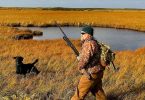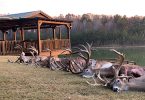Bow hunting elk is one of the most exhilarating and challenging activities for outdoor enthusiasts. Elk are one of the largest species of deer, and they are known for their elusive nature and keen senses, which can make them difficult to hunt. However, they are majestic animals that require much patience, skill, and knowledge to hunt successfully. This content will discuss the various aspects of bow hunting elk, including the equipment, method, and tips needed to become a successful elk hunter.
Bow Hunting Elk: Equipment
The first step to bow hunting elk is ensuring you have the right equipment. The following are the key pieces of equipment you will need:
-
Bow – The bow is the most important piece of equipment when it comes to bow hunting elk. You need to choose a comfortable bow that suits your shooting style. The most common types of bows for elk hunting are compound bows and traditional bows.
-
Arrows – You need to choose durable arrows designed for hunting big game. The length and weight of the arrow will depend on your bow’s draw weight and your personal preference.
-
Broadheads – Broadheads are the tips of the arrows that are used to penetrate the elk’s skin and organs. There are two types of broadheads – fixed and expandable. Fixed broadheads are more durable, while expandable broadheads are more accurate.
-
Release aid – A release aid is a device that attaches to the bowstring to help you release the arrow more smoothly and accurately.
-
Sight – A sight is a device that helps you aim your bow accurately. You can choose between a single-pin sight or a multi-pin sight.
-
Quiver – The place where you keep your arrows is in a quiver. You can choose between a hip quiver or a bow-mounted quiver.
-
Clothing – You need to wear clothing suitable for the weather and terrain. You should wear layers of clothing that can be easily removed or added depending on the temperature. It is also important to wear clothing that blends in with the environment.
A successful bow hunt for elk requires careful preparation and the right equipment. Select a bow and arrows that match your hunting type, invest in quality optics and clothing, and bring essential gear such as a rangefinder, release aid, and game processing kit. You’ll be ready for an unforgettable hunting experience with the right equipment and preparation.
Bow Hunting Elk: Tips and Strategies for a Successful Hunt
-
Know Your Prey
The first step to a successful elk hunt is to know your prey. Elk are social animals and live in large herds, usually in mountainous or forested areas. They are herbivores and feed on grasses, leaves, bark, and twigs. Elk are active during the day and night, but they tend to be more active during the early morning and late evening. During the day, elk often rest in shaded areas or in the cover of trees.
Elk have excellent senses, including hearing, sight, and smell, which makes them difficult to approach undetected. They can detect human scent from long distances, so it’s important to reduce your scent.
-
Obtain the Right Equipment
To hunt elk, you will need a good bow, arrows, and other equipment. A compound bow is the most common type of bow used for elk hunting, as it provides more power and accuracy than a traditional recurve bow. Your bow should have a draw weight of at least 50 pounds, preferably 60 pounds or more, to be effective against an elk.
You will also need arrows that are specifically designed for elk hunting. These arrows should be heavy and have a broadhead tip, which will penetrate an elk’s thick hide and bones. It’s important to practice shooting your bow and arrows regularly to ensure accuracy and consistency.
You will also need a hunting knife, a pack to carry your gear, binoculars, and a rangefinder. You may also want to consider using scent-reducing clothing and gear to reduce your scent and increase your chances of success.
-
Scouting and Planning
Before your elk hunt, it’s important to scout the area and plan your hunt. Look for areas where elk are known to frequent, such as feeding and watering areas. You can also look for elk tracks, droppings, and bedding areas to get an idea of where the elk are moving.
Planning your approach carefully is important, as elk are easily spooked. Try to approach from downwind and stay hidden as much as possible. To maximize your odds of success, you might also think about using a ground blind or a tree stand.
-
Calling and Decoying
Elk are very vocal animals, and calling can be an effective way to attract them. There are several types of elk calls, including bulges, cow calls, and calf calls. Bugles are used to imitate a bull elk’s mating call, while cow calls and calf calls can be used to imitate female and young elk.
Decoying can also be an effective way to attract elk. Elk decoys come in various sizes and shapes and can be set up in a feeding or watering area to attract elk. Decoys can be used with calling to increase your chances of success.
-
Shot Placement
Shot placement is crucial when bow hunting elk. Elk have thick hide and bones, so it’s important to aim for the vital organs to ensure a quick and humane kill. The ideal shot placement is behind the elk’s front shoulder, in the lungs or heart.
It’s important to practice shot placement on a target before your hunt to ensure accuracy and consistency.
Bow Hunting Elk: Method
Bow hunting elk can be a thrilling and rewarding experience for those who are prepared to devote the time and effort necessary to plan and carry out a successful hunt. Here is a step-by-step guide to bow hunting elk:
-
Obtain the necessary permits and licenses:
Before planning a bow hunting trip for elk, it is important to check with the local wildlife agency to determine the requirements for obtaining permits and licenses. This may include a hunting license, elk tag, and special permits for specific hunting areas.
-
Choose a hunting location:
Elk hunting locations can vary depending on the region and season. Some popular locations for elk hunting include public lands, national forests, and private ranches. It is important to research the area and ensure that hunting and any specific regulations or requirements are allowed.
-
Plan your hunt:
A successful elk hunt requires careful planning and preparation. This includes scouting the area beforehand to locate elk and identify potential hunting spots, as well as preparing necessary gear such as bows, arrows, camouflage clothing, and hunting boots.
-
Set up camp:
Once you have identified a hunting location, it is important to set up camp in a safe and strategic location. This may include setting up a tent, preparing a fire, and securing food and supplies to avoid attracting wildlife.
-
Practice shooting:
Bow hunting elk requires skill and accuracy in shooting. It is important to practice shooting with your bow and arrows regularly before the hunt to ensure that you are comfortable and confident in your shooting ability.
-
Spot and stalk:
Spot and stalk are common hunting methods used for elk. This involves scouting the area for elk and stalking them on foot, using stealth and cover to get as close as possible for a shot.
-
Use calls:
Elk calls can attract elk to your location or lure them into range for a shot. This may include using bugle calls or cow calls to mimic elk vocalizations.
-
Take the shot:
When identifying an elk within range, it is important to take a careful and ethical shot. Aim for the vital organs, such as the heart or lungs, to ensure a clean and quick kill.
-
Retrieve the elk:
Once you have taken a successful shot, it is important to retrieve the elk as quickly as possible. This may involve tracking the animal, field dressing it, and transporting it back to camp for processing.
-
Process the meat:
Elk meat can provide a nutritious and delicious source of food. It is important to properly process and store the meat, including cleaning and quartering the animal, wrapping and freezing the meat, and preparing it for cooking and consumption.
Overall, bow hunting elk requires careful planning, preparation, and execution to ensure a successful and ethical hunt. With the right gear, skills, and strategy, you can have an unforgettable hunting experience while also respecting and protecting the natural environment and wildlife.








